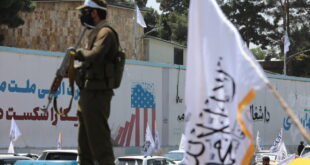U.S. officials think Kabul could fall to the Taliban within six months, a sad indictment of our multibillion effort to build security there.
It is hard to be in a war, but sometimes even harder to leave. One reason is that a war’s goals may remain unfulfilled. Wise states do not enter wars whose goals are not important to their own security. The fear of those unfulfilled goals sustains the war.
This is the case in Afghanistan. After crushing Al Qaeda and punishing the Taliban early in the war, the United States has been waging a war of nation-building and nation-holding — serving as a crutch for the Afghan government until the Afghan government can stand on its own. Central to that has been building up the Afghan National Security Forces (ANSF) — the military and police that must push back the Taliban and other enemies of the Afghan state.
Yet the failures of these forces are daily news these days. Afghan troops are surrendering in droves. The Taliban is seizing territory and capturing enough U.S.-supplied gear to fill an arsenal. It is no wonder some are calling on the United States to abandon its plans to leave the war. Indeed, with Afghan leaders Abdullah Abdullah and Ashraf Ghani coming to Washington for a meeting with President Joe Biden on Friday, these views may be aired in the White House. But the U.S. choice in Afghanistan remains what it always was: leave and likely see the collapse or fragmentation of the state or stay forever propping up a nation that will never be built.
Critics of the U.S. exit from Afghanistan have lost sight of the whole reason we have been in Afghanistan for so long: that unfulfilled goal. The Afghan National Security Forces remain unable to provide security to Afghanistan. Their collapses are not a reason to stay and keep building, as the critics hold, but confirmation that the nation-building mission has failed. The United States has been unable to build what it has stayed in Afghanistan to build.
Donald Trump and Joe Biden are not the first American presidents to encounter this ugly choice. Ronald Reagan pulled American forces from their unfulfilled peacekeeping mission in Lebanon in early 1984. Recent work by Alexandra T. Evans and A. Bradley Potter shows how hard this decision was for the president. In contrast to popular memory, Evans and Potter show, Reagan had not been prompted to withdraw by rising casualties — including high-profile incidents like the Marine Corps barracks bombing — or by public skepticism of the war. Indeed, Reagan remained resolute in pursuit of the intervention through all of that. Reagan had a “theory of success” for the conflict that will sound familiar to us today: that “the Lebanese government could, with sufficient U.S. support, reassert control without a wider American ground presence.”
The Lebanese Armed Forces played a key role in that reassertion. Yet they collapsed in early February 1984 in the face of a militia offensive. Mass desertions and rapid loss of critical territory “provided decisive evidence that the U.S. strategy in Lebanon had failed,” write Evans and Potter. Reagan, they state, had to choose between an expanded U.S. mission in Lebanon or a quick withdrawal. He chose the latter option, and the Marines were out in a few weeks. It was a tough call – one that required looking a failed theory of success squarely in the eye.
We are at a similar point in Afghanistan. All hope of the Afghan government reasserting lasting control is gone. The ANSF has not collapsed yet, but that point may not be far off. The Wall Street Journal’s Gordon Lubold and Yaroslav Trofimov report that U.S. intelligence agencies “concluded last week that the government of Afghanistan could collapse as soon as six months after the American military withdrawal from the country is completed.” Ethnic militias are pouring into the streets to help defend key cities, a sign of ANSF insufficiency and perhaps of coming fragmentation. Major highways are under growing Taliban threat. U.N. special envoy Deborah Lyons reported this week that “more than 50 of Afghanistan’s 370 districts have fallen since the beginning of May,” adding that the advances appeared to be an attempt to surround and eventually seize provincial capitals. Thirteen district centers fell in just twenty-four hours earlier this week, and the total is now up to eighty.
Some of these Taliban advances have come thanks to a wave of ANSF surrenders. Meanwhile, overworked Afghan special operators, the government’s most effective fighting force, are taking heavy casualties. Foreign contractors critical to keeping the Afghan Air Force flying are leaving, too, with the New York Times’ Thomas Gibbons-Neff, Helene Cooper, and Eric Schmitt reporting that the U.S. advisory mission “concluded in January that no Afghan aircraft could be sustained as combat effective for more than a few months in the absence of contractor support.” And diplomats in Kabul are placing their bets on Turkish troops, not the ANSF, to ensure the security of the airport — their escape route in the event of a Taliban assault.
A closer look at these data points reveals the underlying failure of the mission to build the ANSF and Afghanistan as a whole. The Associated Press’s Kathy Gannon tells of a police official who observed that:
“The police fighting in the districts are mostly from poor families. Those families have remained poor despite the trillions of dollars spent in Afghanistan in the past 20 years. “They have not seen changes in their lives and are indifferent so they see no difference. … They want to save their lives just for today.”
The heavy strain on special operators and the surrender wave suggest a military whose regular units cannot reliably generate sustained combat power or hold up under pressure. It is hard to blame some of them too much — reports are rife of inadequate ammunition and weaponry and of unpaid salaries. But on the other side of the ledger, they are playing defense. Forces on the attack are usually expected to need a numerical advantage of two to one, three to one, or even more to overcome the natural advantages of defensive fighting.
Similarly, the flight of the contractors is more than a threat to the usability of the Afghan Air Force. It is also a reminder that the ANSF has not generated enough of its own maintainers. Indeed, some aircraft are exclusively maintained by contractors. The Afghan National Army (ANA) and Afghan National Police (ANP) have actually seen their maintenance capacity decline “over the last two years,” according to the Special Inspector General for Afghanistan Reconstruction: “as of November 2018, the ANA was responsible for 51.1 percent of its vehicle maintenance and the ANP only 15.9 percent. As of December 2020, the ANA was completing just under 20 percent of maintenance work orders, and the ANP slightly more than 12 percent.” And if Afghanistan’s helicopters go out of service, men on the ground may have no way out when wounded — a sure blow to morale.
Much has been made of the fact that there are now Americans deploying to Afghanistan who were born after we entered the war there. Yet few have pointed out that this puts the problem of the Afghan military in new light. The United States government may have spent only a few months or years molding its most junior personnel before deploying them to Afghanistan. The United States has spent an entire generation molding the Afghan military for the same fight. Yet it is only those fresh-faced Americans that we believe can keep the Taliban at bay. The contractors would not leave if they trusted the ANSF to keep them safe. U.S. and other foreign diplomats in Kabul have cast a similar vote of no confidence. Before Turkey agreed to continue its mission at Kabul’s airport, the main alternative under consideration was private contractors, not the ANSF. And, of course, those militias would not be turning out to hold off the Taliban if they considered the ANSF up to the task.
There is no doubt that many members of the Afghan military have fought bravely and sacrificed deeply for their homeland. But an effective fighting force for securing Afghanistan cannot rely on courage, readiness, and skill from a few individuals or units. It must hold off the Taliban consistently and sometimes push them back — and it must do this across the whole ANSF. It is time for the United States to recognize that our long effort to build the Afghan military is falling apart before our eyes. We can either leave or remain in Afghanistan forever. Reagan made the right call in a similar situation in 1984. Will we?
 Eurasia Press & News
Eurasia Press & News


